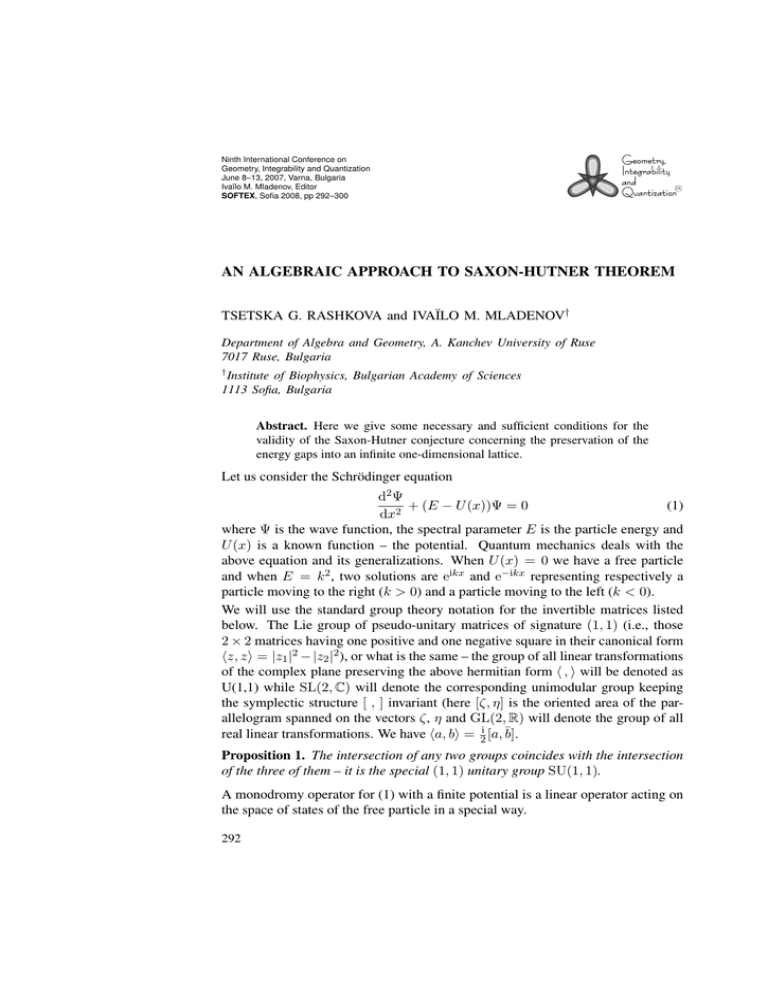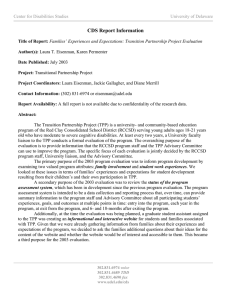Geometry, Integrability
advertisement

Ninth International Conference on
Geometry, Integrability and Quantization
June 8–13, 2007, Varna, Bulgaria
Ivaïlo M. Mladenov, Editor
SOFTEX, Sofia 2008, pp 292–300
Geometry,
Integrability
and
IX
Quantization
AN ALGEBRAIC APPROACH TO SAXON-HUTNER THEOREM
TSETSKA G. RASHKOVA and IVAÏLO M. MLADENOV†
Department of Algebra and Geometry, A. Kanchev University of Ruse
7017 Ruse, Bulgaria
†
Institute of Biophysics, Bulgarian Academy of Sciences
1113 Sofia, Bulgaria
Abstract. Here we give some necessary and sufficient conditions for the
validity of the Saxon-Hutner conjecture concerning the preservation of the
energy gaps into an infinite one-dimensional lattice.
Let us consider the Schrödinger equation
d2 Ψ
+ (E − U (x))Ψ = 0
(1)
dx2
where Ψ is the wave function, the spectral parameter E is the particle energy and
U (x) is a known function – the potential. Quantum mechanics deals with the
above equation and its generalizations. When U (x) = 0 we have a free particle
and when E = k 2 , two solutions are eikx and e−ikx representing respectively a
particle moving to the right (k > 0) and a particle moving to the left (k < 0).
We will use the standard group theory notation for the invertible matrices listed
below. The Lie group of pseudo-unitary matrices of signature (1, 1) (i.e., those
2 × 2 matrices having one positive and one negative square in their canonical form
hz, zi = |z1 |2 − |z2 |2 ), or what is the same – the group of all linear transformations
of the complex plane preserving the above hermitian form h , i will be denoted as
U(1,1) while SL(2, C) will denote the corresponding unimodular group keeping
the symplectic structure [ , ] invariant (here [ζ, η] is the oriented area of the parallelogram spanned on the vectors ζ, η and GL(2, R) will denote the group of all
real linear transformations. We have ha, bi = 2i [a, b̄].
Proposition 1. The intersection of any two groups coincides with the intersection
of the three of them – it is the special (1, 1) unitary group SU(1, 1).
A monodromy operator for (1) with a finite potential is a linear operator acting on
the space of states of the free particle in a special way.
292
293
An Algebraic Approach to Saxon-Hutner Theorem
Proposition 2. The matrix of the monodromy operator in the basis (eikx , e−ikx ) is
an element of the group SU(1, 1), where
SU(1, 1) = MA =
wA + iζA υA + iηA
υA − iηA wA − iζA
∈ M2 (C) ; det(MA ) = 1 .
Actually, we speak about groups of operators but the matrices of these operations
are elements of SU(1, 1) in the considered basis (eikx , e−ikx ). The matrix groups
SL(2, R) and SU(1, 1) are isomorphic. We get from them one and the same group
of operators. For the real basis (e1 , e2 ) these matrices are in SL(2, R) and for the
complex conjugate basis (eikx , e−ikx ) they are elements of SU(1, 1). Geometrically, going from SL(2, R) to SU(1, 1) means transforming Lobachevski’s plane
model in the upper half plane to a model in the unit circle.
In 1949 Saxon and Hutner [8] have announced a conjecture concerning the coupling of impurities introduced into an infinite one-dimensional crystal lattice.
Conjecture 1. Forbidden energies that are common to the pure A crystal and the
pure B crystal (with the same lattice constant) will always be forbidden in any
arrangement of A and B atoms in a substitutional solid solution.
This can be easily reformulated using the transfer-matrix formalism [4]. As the
concept of the transfer matrix has been used extensively in transport theory, optics and engineering [2, 3, 7] let us remind that by its very definition the transfer
matrix M relates the wave functions (states, amplitudes) on either side of the potential (force). The crucial point in using this formalism is the observation that real
localized potentials and transfer matrices are in a one-to-one correspondence. The
group nature permits defining a total transfer matrix for an arbitrary sequence of
potentials as a product of their individual matrices. The forbidden energies for
an electron propagating in a periodic lattice are given by the condition tr M > 2,
where M is a transfer (monodromy) matrix of a unit cell. Thus we can ask:
Question 1. Under what conditions for any arrangement Ar1 B s1 . . . Ark B sk of A
and B atoms (ri , sj ∈ Z+ ) we have tr(MAr1 MBs1 . . . MArk MBsk ) > 2 provided that
tr(MA ) > 2 and tr(MB ) > 2?
Various conditions for the validity of the above statement are discussed in [4–6]
and [9] in the context of one-dimensional quantum mechanics which will have in
mind in this paper as well.
For convenience from now on we denote the transfer matrices by A, B. We give
the following necessary and sufficient condition:
Theorem 1. Let A and B be two elements of the group SU(1, 1) such that tr A > 2
and tr B > 2. Then tr(AB) > 2 if and only if
(wA − wB )2 + (ζA + ζB )2 < (ηA + ηB )2 + (υA + υB )2 .
294
Tsetska G. Rashkova and Ivaïlo M. Mladenov
Proof: The condition tr(AB) > 2 gives
2wA wB − 2ζA ζB + 2υA υB + 2ηA ηB > 2.
2 + ζ 2 − υ 2 − η 2 = w 2 + ζ 2 − υ 2 − η 2 = 1 we get
Taking into account that wA
A
A
A
B
B
B
B
the desired inequality.
For tr A = tr B we get (ζA + ζB )2 < (υA + υB )2 + (ηA + ηB )2 .
Remark 1. The necessary and sufficient condition of Theorem 1 could be expressed as det(A + B) < tr A tr B.
Really det(A + B) = (wA + wB )2 + (ζA + ζB )2 − (ηA + ηB )2 − (υA + υB )2 and
thus we get det(A + B) < tr A tr B.
We could formulate the following sufficient condition:
SC 1. Let det(A + B) < tr A tr B provided that tr A > 2 and tr B > 2. Then
tr(AB) > 2.
Exchanging SU(1, 1) for SL(2, R) using the group homomorphism
M=
w + iζ υ + iη
υ − iη w − iζ
−→ r(M ) =
w−υ η+ζ
η−ζ w+υ
one could associate with any transfer matrix a complex three-dimensional vector
cM =
1
(−iη, −ζ, iυ).
w
(2)
In [6] one could find the following
SC 2 ([6, p. 995]). The conditions cA .cB < 0 and (cA × cB )2 < 0 are sufficient
for the validity of the Saxon-Hutner theorem.
In this setting, symmetric potentials are represented by vectors, whose third component is identically zero and this implies that they can be considered as elements of a pseudo-Euclidean plane of index one. In such a plane the condition
(cA × cB )2 < 0 is satisfied automatically and SC2 is transformed into the inequality ωA1ωB (−ηA ηB + ξA ξB ) < 0, which is equivalent to the Tong and Tong [6]
criterion, namely
SC 3. Let sign(wA wB ) = sign(ηA ηB − ζA ζB ) when both tr A > 2 and tr B > 2.
Then tr(AB) > 2.
Proposition 3. In the symmetric case SC2 is equivalent to SC3.
Proposition 4. In the symmetric case SC3 is a stronger condition than SC1, i.e.,
SC1 follows from SC3.
An Algebraic Approach to Saxon-Hutner Theorem
295
Proof: The inequality in Theorem 1 could be rewritten as
wA wB − ζA ζB + ηA ηB > 1.
Clearly, the Tong and Tong criterion, namely wA wB > 1 and ηA ηB − ζA ζB > 0
gives wA wB − ζA ζB + ηA ηB > 1.
We look for other sufficient conditions as well.
Our next step is to consider the characteristic polynomial of the matrix A + xB
for arbitrary x. Classifying pairs of n × n matrices (A, B) under the simultaneous
similarity (T AT −1 , T BT −1 ) Friedland has shown in [1] that if n = 2 and U is
the set of pairs (A, B) such that |λE − (A + xB)| = 0 splits into a product of two
linear factors, then U could be defined as
U = {(A, B) ; (2 tr(A2 ) − tr2 A)(2 tr(B 2 ) − tr2 B) = (2 tr(AB) − tr A tr B)2 }.
We work really in U ∗ = U ∩ SU(1, 1) and can prove the following:
SC 4. Let A, B ∈ SU(1, 1) such that tr A > 2, tr B > 2, tr A 6= tr B and
the characteristic polynomial |λE − (A + xB)| is reducible over C[λ, x]. Then
tr(AB) > 2.
Proof: Starting with (tr A − tr B)2 > 0, we rewrite it as
tr A tr B − 4 >
q
(tr2 A − 4)(tr2 B − 4).
(3)
The Cayley-Hamilton theorem gives A2 − tr A.A + E = 0 and taking traces we
get
tr(A2 ) = tr2 A − 2, i.e., 2 tr(A2 ) − tr2 A = tr2 A − 4.
(4)
I) Let |λE − (A + xB)| splits into two linear factors. Thus the Friedland’s representation gives
q
± (tr2 A − 4)(tr2 B − 4) = 2 tr(AB) − tr A tr B.
Considering the sign possibilities we get:
q
• For the positive case 2 tr(AB) = tr A tr B+ (tr2 A − 4)(tr2 B − 4), i.e.,
tr(AB) > 2.
• In the negative one, we get respectively
q
− (tr2 A − 4)(tr2 B − 4) = tr(AB) − tr A tr B
which combined with the inequality
q
− (tr2 A − 4)(tr2 B − 4) > 4 − tr A tr B
from (3) gives exactly tr(AB) > 2.
296
Tsetska G. Rashkova and Ivaïlo M. Mladenov
II) Let |λE − (A + xB)| be a square of a linear factor. Friedland describes the set
V of such matrices A, B as
V = {(A, B) ; 2 tr(A2 ) = tr2 A, 2 tr(B 2 ) = tr2 B, 2 tr(AB) = tr A tr B}.
This is not the case for tr A > 2 and tr B > 2 (because of (4) the equality tr(A2 ) =
tr2 A gives tr A = 2, analogously tr B = 2, a contradiction with the assumption).
Remark 2. For tr A = tr B > 2, the reducibility of the considered characteristic
polynomial guarantees only that tr(AB) ≥ 2.
Proof: The definition of U ∗ gives in this case
(2 tr(A2 ) − tr2 A)2 = (2 tr(AB) − tr2 A)2 .
It could be written as
(2 tr(A2 ) − tr2 A − 2 tr(AB) + tr2 A)(2 tr(A2 ) − tr2 A + 2 tr(AB) − tr2 A) = 0
i.e., either
a) tr(AB) = tr(A2 ) > 2 or
b) tr(AB) = tr2 A − tr(A2 ) = 2 as (4) is valid.
Remark 3. Using the computer algebra system Mathematica, we get the following expression for U ∗
2
2
2
2
2
2
(ηA
+ υA
− ζA
)(ηB
+ υB
− ζB
) = (ηA ηB + υA υB − ζA ζB )2
i.e.,
c2A .c2B = (cA .cB )2 .
As (cA × cB )2 = c2A .c2B − (cA .cB )2 , i.e., (cA × cB )2 = 0 we see that SC4 does
not include the symmetric case as Proposition 3 is valid.
√
As an example of√concrete matrices A and B, let us take wA = 2, ζA = ηA =
υA = 1, wB = 3, ζB = 0, ηB = υB = 1, so that tr(AB) > 2 although the
characteristic polynomial is not reducible. This proves again that the condition
wA wB − ζA ζB + ηA ηB > 1
is only a sufficient one. Nevertheless it is inequality for the three parameters only.
Another proof of SC4: We apply the canonization theory to the quadratic
f (x, λ) = |A + xB − λE|
= x2 − 2λxwB + 2x(wA wB + ζA ζB − υA υB − ηA ηB ) + λ2 − 2λwA + 1.
297
An Algebraic Approach to Saxon-Hutner Theorem
1 − λ −wB = 0 gives two eigenvalues λ1 = 1+wB
The characteristic equation −wB 1 − λ
√ √ and λ2 = 1 − wB . The corresponding eigenvectors are e1 =
e2 =
√
√ − 2 − 2
.
,
2
2
The transformation
√
− 2
λ=
λ̃ + x̃ ,
2
− 2
2
2 , 2
and
√ 2
x=
λ̃ − x̃
2
gives f x̃, λ̃ = λ1 λ̃2 + λ2 x̃2 + 2b1 λ̃ + 2b2 x̃ + b3 , where ∆ = λ1 λ2 < 0
and the quadratic form represents two crossing lines when c = 0, where c =
b3 − b21 /λ̃ − b22 /x̃.
In our case,
√
√
2
2
b1 =
wA +
(wA wB + ζA ζB − υA υB − ηA ηB )
2
2
√
√
2
2
b2 =
wA −
(wA wB + ζA ζB − υA υB − ηA ηB )
2
2
b3 = 1.
Then
c=1−
1
[w2 + (wA wB + ζA ζB − υA υB − ηA ηB )2
(1 − wB )2 A
− 2wa wB (wA wB + ζA ζB − υA υB − ηA ηB )].
The condition c = 0 gives
2
wA
+ (wA wB + ζA ζB − υA υB − ηA ηB )2
2
− 2wa wB (wA wB + ζA ζB − υA υB − ηA ηB ) = 1 − wB
.
This could be easily transformed to
2
2
2
2
2
2
2
2
(ζA ζB − υA υB − ηA ηB )2 = (1 − wA
)(1 − wB
) = (ηA
+ υA
− ζA
)(ηB
+ υB
− ζB
)
which is the simplified expression for U ∗ as pointed out in Remark 3.
There are no other possibilities for the singularity of the considered quadratic form.
The next step is to consider the arrangements Ar1 B s1 . . . Ark B sk provided that
tr A = tr B > 2 and tr(AB) > 2. Direct computations in this case show that
tr(Ar1 B r2 Ar3 B r4 ) > 2 for 2 < r1 + r2 + r3 + r4 ≤ 5.
The main tools for proving it are:
a) equality (4) and
b) the equality tr(AB) = tr A tr B − tr(BA−1 ) proved directly for unimodular
matrices in [5, equation (23)]. For tr A = tr B it gives
tr(AB) = tr2 A − tr(BA−1 ).
(5)
298
Tsetska G. Rashkova and Ivaïlo M. Mladenov
For the general case we could prove
Lemma 1. Let k ∈ N. Then tr(Ak ) > tr A.
Proof: For k = 2, (4) gives tr(A2 ) = tr2 A − 2 > tr A for tr A > 2. Item b)
above gives tr(A3 ) = tr A tr(A2 )−tr A = tr A(tr(A2 )−1) > tr A and tr(A4 ) =
tr(A2 )2 = tr2 A2 − 2 > 2, using (4) again.
Then we proceed by induction. Let tr(As ) > tr A for every s < 2k + 1. Then
tr(A2k+1 ) = tr(Ak ) tr(Ak+1 ) − tr A > tr2 A − tr A = tr A(tr A − 1) > tr A.
Lemma 2. Let tr A = tr B > 2 and tr AB > 2. Then tr(A2k+1 B) > tr(AB)
and tr(A2k B) > tr A for every integer k.
Proof: For k = 1, tr(A2 B) = tr A tr(AB) − tr A = tr A(tr(AB) − 1) > tr A.
Conditions (5), tr(AB) > 2 and (4) give consequently
− tr(BA−1 ) = tr(AB) − tr2 A > 2 − tr2 A = − tr A2 .
Thus
tr(A3 B) = tr(A2 ) tr(AB) − tr(BA−1 ) > tr(A2 ) tr(AB) − tr(A2 )
= tr(A2 )(tr(AB) − 1)
> 2(tr(AB) − 1) > tr(AB)
as
tr(AB) > 2.
Then we can proceed by induction. Let tr(As B) > tr(AB) for any odd s < 2k+1
(k is fixed) and tr(As B) > tr A for any even s < 2k. Applying tr(A2 B) > tr A
for A = Ak we get
tr(A2k B) = tr (Ak )2 B > tr(Ak ) > tr A
as Lemma 1 is valid.
Let k be even. Then
tr(A2k+1 B) = tr(Ak ) tr(Ak+1 B) − tr(AB)
> (tr2 (Ak/2 ) − 2) tr(AB) − tr(AB)
> 2 tr(AB) − tr(AB) = tr(AB).
An Algebraic Approach to Saxon-Hutner Theorem
299
Let k be odd. Then using (5) we get
tr(A2k+1 B) = tr Ak+1 tr Ak B − tr BA−1
> tr2 A
k+1
2
− 2 tr(AB) + 2 − tr2 A
> tr2 A − 2 tr(AB) + 2 − tr2 A
= tr2 A − 2 (tr(AB) − 1) > 2(tr(AB) − 1) > tr(AB).
Lemma 2 shows that tr As BAk > 2 for all s, k provided that tr A > 2, tr B > 2
and tr(AB) > 2.
Remark 4. In the general case (i.e., when tr A 6= tr B and relying on vector
parametrization (2)) one can see that (5) can be rewritten in the form
1
tr(MX ),
X = A, B, AB
2
which means that the second condition in SC2 is actually superfluous. In the same
time it is easy to prove that
t(AB) = t(A)t(B)(1 − cA .cB ),
cAk = αk (cA )cA ,
t(X) =
αk (cA ) ∈ R+ ,
k = 1, 2, 3, . . .
so that the validity of the Saxon-Hutner conjecture for Am B, AB m , and Am B n
for m, n ∈ N is obvious.
Acknowledgements
The first author is partially supported by a Grant MM1503/2005 from Bulgarian
Foundation for Scientific Research. Both authors are quite grateful to Professor
Clementina Mladenova from the Institute of Mechanics, Bulgarian Academy of
Sciences, for providing an access to her computer and computer algebra system
Mathematicar via which some of the calculations presented here were done.
References
[1] Friedland S., Simultaneous Similarity of Matrices, Adv. Math. 50 (1983) 189–265.
[2] Khorosani S. and Adibi A., New Analytical Approach for Computation of Band Structures in One-Dimensional Periodic Media, Opt. Comm. 216 (2003) 439–451.
[3] Langley R., A Transfer Matrix Analysis of the Energetics of Structural Wave Motion
and Harmonic Vibration, Proc. R. Soc. Lond. A 452 (1996) 1631–1648.
[4] Mladenov I., Geometry of the Saxon-Hutner Theorem, Phys. Lett. A 230 (1997) 245–
252.
300
Tsetska G. Rashkova and Ivaïlo M. Mladenov
[5] Mladenov I., The Matrizant and Saxon-Hutner Theorem, J. Phys. A: Math. Gen. 30
(1997) 1689–1694.
[6] Mladenov I., On the Saxon-Hutner Theorem, CRAS (Sofia) 38 (1985) 993–996.
[7] Pendry J., Symmetry and Transport of Waves in One-Dimensional Disordered Systems, Adv. Phys. 43 (1994) 461–542.
[8] Saxon S. and Hutner A., Some Electronic Properties of One-Dimensional Crystal
Model, Philips Res. Rep. 4 (1949) 81–122.
[9] Tong B. and Tong S., Saxon-Hutner Theorem for One-Dimensional General Alloys,
Phys. Rev. 180 (1969) 739–743.





